Building of the Month - December 2016


| The Rank Silo overlooking the docks in Limerick is one of the last surviving structures of Shannon Mills, at one time one of the largest flour milling complexes in Great Britain and Ireland.
Joseph Rank Limited, today Rank Hovis McDougall (“RHM”), was founded by Joseph Rank (1854-1943) in Hull in 1875 and expanded to Scotland and Ireland in the late 1920s. After a visit to Limerick, Rank decided that the city would make an ideal headquarters for the newly established Irish subsidiary, Rank (Ireland) Limited, and took over the Goodbody Group in 1930. As part of their takeover Rank acquired the City Mill, the Mallow Street Mill, the Mount Kennett Provender Mill and the Newtown Pery Mill in addition to numerous grain silos. Nevertheless, it was decided that a new modern mill on the docks was required to cut transportation costs. However, in January 1932 Seán Lemass (1899-1971), Minister for Industry and Commerce, refused to grant the licence necessary for the construction of a line from Colbert Railway Station to the docks owing to Fianna Fáil’s policy prohibiting the expansion of non-Irish mills. |
Work on the construction of a suite of new grain silos began in earnest in early 1932 with the contractor using local labourers to carry out the work. The new silos would see steam power give way to electricity supplied by the new hydroelectric generating station at Ardnacrusha. So too the bricks and stone of traditional mill buildings were replaced by innovative materials and construction techniques. Using a system of reinforced concrete, progress on the first silo was swift with the walls rising at a rate of four feet per day. However, the steel used to reinforce the concrete was in short supply and had to be sourced from across Europe.
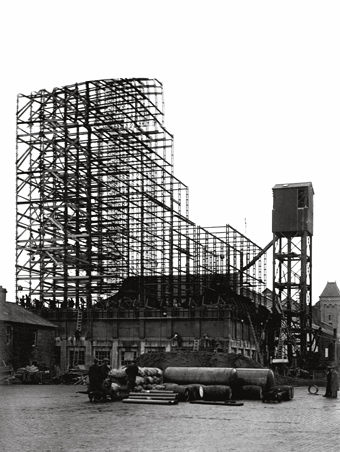 |
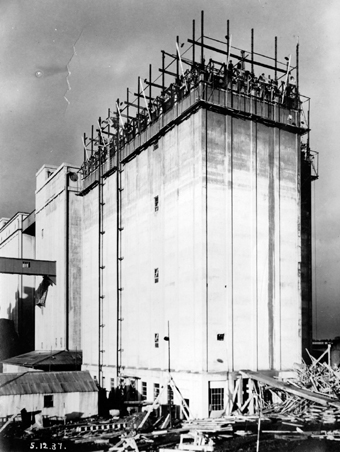 |
Left: from Franz S. Haselbeck’s Ireland (2013) compiled by Patricia Haselbeck Flynn and published by The Collins Press. Reproduced by permission of Patricia Haselbeck Flynn. © The Haselbeck Collection
|
The surviving silo was completed in 1935 to meet the requirements of the government’s wheat-growing scheme and was ‘fitted with up-to-date grain-handling machinery and plant for the drying of Irish wheat’ [1]. The design of the silo has been attributed to Beckett and Harrington (formed 1918) of Cork and Dublin with the attribution supported by a similar silo at the Marina Mills in Cork. An early and rare example of a ferro-cement or ferro-concrete building, the structure comprises concrete – cement, sand and water – poured and set over a layer of metal mesh and closely-spaced thin steel rods. Although a largely unadorned tower whose appearance is redolent of early twentieth-century modernism, the silo can be read as the continuation of an architectural story dating back over centuries. Much as function over form was espoused by the Gothic Revivalists of the nineteenth century, the celebration of function was one of the tenets of modernism. In Limerick the function of the interior space is clearly expressed on the exterior with a series of square openings at street level lighting the offices; vast expanses overhead devoid of openings but showing the rib-like concrete piers of the construction; and a series of paired oculus openings at the uppermost level. Going further back to Classical antiquity the vertical divisions of base (plinth), centre (shaft) and top (capital) recall the components of a fluted column. |
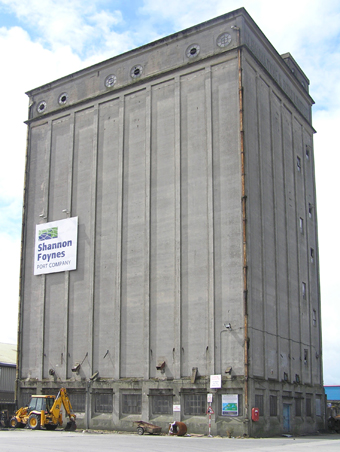 |
A rare concession to “ornamentation” comes in the form of slightly elongated low-relief raised lettering below the parapet which unexpectedly shows the name not of Rank (Ireland) Limited but J. BANNATYNE & SONS LIMITED.
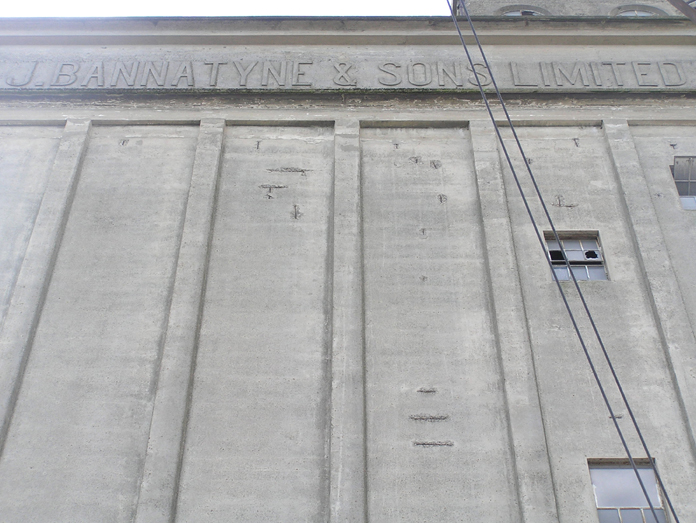
The full complement of silos was complete in 1937 with the resulting austere silhouette making a distinctive, if not always appreciated impression on the docklands skyline.
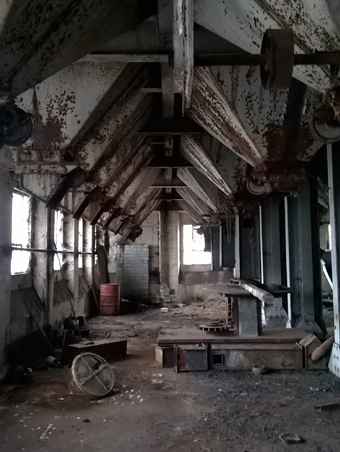 |
The Shannon Mills were an important source of employment in Limerick throughout the 1940s and 1950s with five hundred permanent employees and a workforce of 1,000 during the wheat season. In addition to contributing to the livelihood of the citizens, the mills had a positive impact on the economy of the hinterlands and the farmers who grew and supplied the wheat. Crucially, the mills helped to keep the city and country alive during the Second World War when food supplies could not be imported. However, profits began to fall in the 1960s and Ireland’s entry into the EEC in the 1970s saw the market for home produce dwindle in the face of cheaper foreign imports. Rank (Ireland) Limited was forced to close in 1983. The first silo was lost in the summer of 1989 although its demolition was not without its challenges. The reinforced concrete proved remarkably resilient. The first attempt at demolition using 750lbs of Frangex explosives caused the silo to merely “quake” [2]. On the second attempt, using 850lbs of explosives, the structure ‘just jumped ten feet in the air and sat down’ [3]. Its jaunty 75 degree angle quickly earned it the soubriquet The Leaning Tower of Limerick. Adopting a less-is-more approach, the third attempt used 450lbs of Frangex ‘but did not appear to have the slightest effect on the stubborn silo’ [4]. The silo eventually succumbed to the wrecker’s ball in July 1989 with its destruction making the headlines of The Limerick Leader. |
|
The surviving silo is a Protected Structure. However, a petition by Shannon Foynes Port Company in 2006 called for its removal from the Record of Protected Structures to allow for its demolition and the development of the vacant site. Happily, public awareness of the significance of the building, and the significance of Limerick’s increasingly endangered twentieth-century architectural heritage, has grown in recent years and the silo has been a popular attraction during Open House Limerick. Its reputation was further enhanced by a joint exhibition by the Hunt Museum and Limerick City Archives called Ranks: A Limerick Industry. In an effort to demonstrate that the silo is a candidate for adaptation and reuse DoCoMoMo Ireland organised an international architectural ideas competition in 2014 as part of Limerick City of Culture. The competition, Ranks Silo in the 21st Century, received 131 entries from around the world and the three prize winning entries envisaged the silo repurposed as a national seed vault; a basilica for public events; and a cultural headquarters. Although finding a new purpose for the silo continues to challenge, it stands resolutely overlooking the docks as a monument to Limerick’s proud legacy as an important industrial centre in Ireland. |
 |
Emma Gilleece is an architectural historian and has a Taught Masters in History of Art & Architecture, UL (2010), and a Research Masters in Urban & Building Conservation, UCD (2011). She is Chair of the Built Environment Committee of An Taisce and sits on the committee for the Limerick Chapter of the Irish Georgian Society
1 “Limerick’s New Silo” in The Irish Times (9th August 1935)
2 “Blast it! A damp squib” in Limerick Leader (20th May 1989)
3 “Now It’s The Leaning Tower Of Limerick” in Limerick Leader (3rd June 1989)
4 “Big Bang fails to finish Ranks” in Limerick Leader (June 1989)
5 “Ranks Comes Crashing Down” in Limerick Leader (19th July 1989)
Back to Building of the Month Archive